INDEX
Unleashing Creativity: The Birth of Ideas through External Stimuli and Sustained Intent – Mifune
Mifune’s realization, ‘Humans can only be driven by personal discoveries,’ aligns with the essence of his latest creation. In fact, I’ve pondered that both of you haven’t solely relied on ‘personal discoveries’ in your works until now; instead, they have often been sparked by inquiries and a sense of discomfort with the world.
Kichijomaru: I don’t think that is the first priority in creating artworks, but rather that what you create leads to such things on its own. If I create a work with the goal of changing society in a certain direction, there is a danger that it may be an attempt to impose an ideology on someone else, so I would like to present more open questions. To be honest, I know only a small part of the history and structure of the world, and I have never actually experienced the death of someone in front of me in a war. However, while taking a bird’s-eye view of my own existence, I hope that the ripples that I send out through the medium of myself will spread little by little within the range that I can touch, and if I can create even a small positive cycle in this world, that will be enough.
Mifune: Like myself, in the long history of the world, no one person has ever been able to do anything about society, and I don’t think people will be attracted just by saying that they want to change society. I don’t think people are going to be attracted by just saying, “Isn’t this good? “Isn’t this music fun? It is better to share with those who are close to you, “Isn’t this good? Even if you try to reach a large number of people, you will only be able to reach the superficial.

Mifune: However, I think it is important to reach a handful of people. By doing so, people will listen to our music beyond their reach, and ROTH BART BARON’s music will be popular in a world I don’t know about.
Kichijomaru: By stretching myself just a little bit, the small ripples caused by the work become a little bit bigger, and eventually they connect with ripples in other places and become bigger and bigger. I also believe that this kind of steady repetition is important for both the immediate community and the larger society.
I acknowledge the significance of presenting works within physically connected relationships, as mentioned earlier. Yet, have there been instances for both of you when the creative process became arduous or the flow was disrupted, akin to an abruptly interrupted track?
Kichijomaru: We have the idea and energy to create something, and that idea and energy is output in the form of photographs and music, but I think the feeling of “wanting to share something with beings other than ourselves” applies to everyone. Even if you don’t have that feeling, if you keep your eyes on the world around you, you will probably be on some kind of train without even realizing it.
Mifune: Rick Rubin also said, “All ideas come from the outside, and creativity and output is a reactionary phenomenon of that. I think that ideas rarely come from oneself, but that reaction is as natural to everyone as a hungry stomach. What is important is to become aware of the “magic of the world,” as Mr. Kichijomaru says. If we do so, ideas will continue to be born as long as we live and have the will to do so.

Music and Graphics #002

Thursday, November 9, 2023 – Sunday, December 17, 2023
Venue: OFSGALLERY (in OFS.TOKYO)
Hours: Thu-Mon 12:00~20:00 (until 18:00 on the last day of the exhibition)
URL: https: //ofs.tokyo/about/
Information

ROTH BART BARON Masaya Mifune
RBB “ZINE” BEAR MAG vol.3 – ” 8 ” Photo Book
Wednesday, November 8, 2023
Price: 4,400 yen (tax included)
URL: https: //roth.theshop.jp/items/78634229



























